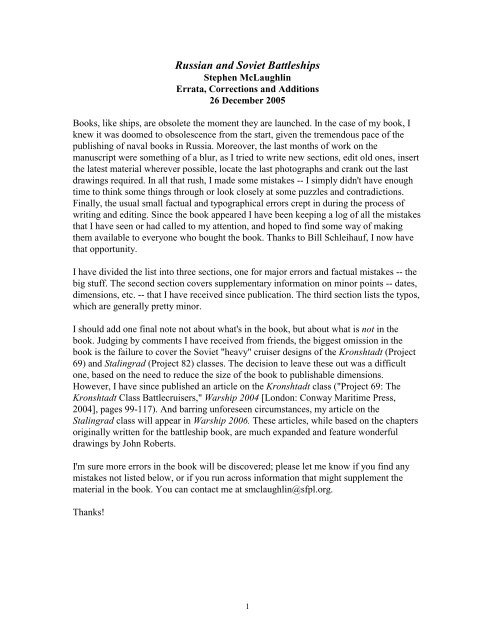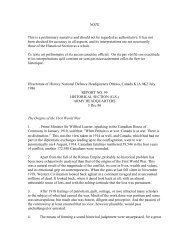Russian and Soviet Battleships - The World War I Document Archive
Russian and Soviet Battleships - The World War I Document Archive
Russian and Soviet Battleships - The World War I Document Archive
You also want an ePaper? Increase the reach of your titles
YUMPU automatically turns print PDFs into web optimized ePapers that Google loves.
<strong>Russian</strong> <strong>and</strong> <strong>Soviet</strong> <strong>Battleships</strong><br />
Stephen McLaughlin<br />
Errata, Corrections <strong>and</strong> Additions<br />
26 December 2005<br />
Books, like ships, are obsolete the moment they are launched. In the case of my book, I<br />
knew it was doomed to obsolescence from the start, given the tremendous pace of the<br />
publishing of naval books in Russia. Moreover, the last months of work on the<br />
manuscript were something of a blur, as I tried to write new sections, edit old ones, insert<br />
the latest material wherever possible, locate the last photographs <strong>and</strong> crank out the last<br />
drawings required. In all that rush, I made some mistakes -- I simply didn't have enough<br />
time to think some things through or look closely at some puzzles <strong>and</strong> contradictions.<br />
Finally, the usual small factual <strong>and</strong> typographical errors crept in during the process of<br />
writing <strong>and</strong> editing. Since the book appeared I have been keeping a log of all the mistakes<br />
that I have seen or had called to my attention, <strong>and</strong> hoped to find some way of making<br />
them available to everyone who bought the book. Thanks to Bill Schleihauf, I now have<br />
that opportunity.<br />
I have divided the list into three sections, one for major errors <strong>and</strong> factual mistakes -- the<br />
big stuff. <strong>The</strong> second section covers supplementary information on minor points -- dates,<br />
dimensions, etc. -- that I have received since publication. <strong>The</strong> third section lists the typos,<br />
which are generally pretty minor.<br />
I should add one final note not about what's in the book, but about what is not in the<br />
book. Judging by comments I have received from friends, the biggest omission in the<br />
book is the failure to cover the <strong>Soviet</strong> "heavy" cruiser designs of the Kronshtadt (Project<br />
69) <strong>and</strong> Stalingrad (Project 82) classes. <strong>The</strong> decision to leave these out was a difficult<br />
one, based on the need to reduce the size of the book to publishable dimensions.<br />
However, I have since published an article on the Kronshtadt class ("Project 69: <strong>The</strong><br />
Kronshtadt Class Battlecruisers," <strong>War</strong>ship 2004 [London: Conway Maritime Press,<br />
2004], pages 99-117). And barring unforeseen circumstances, my article on the<br />
Stalingrad class will appear in <strong>War</strong>ship 2006. <strong>The</strong>se articles, while based on the chapters<br />
originally written for the battleship book, are much exp<strong>and</strong>ed <strong>and</strong> feature wonderful<br />
drawings by John Roberts.<br />
I'm sure more errors in the book will be discovered; please let me know if you find any<br />
mistakes not listed below, or if you run across information that might supplement the<br />
material in the book. You can contact me at smclaughlin@sfpl.org.<br />
Thanks!<br />
1
Section I: Factual Mistakes<br />
Note: When counting lines, the heading (e.g., "Design <strong>and</strong> Construction," "General<br />
Features," etc.) is counted as one line, while the blank lines above <strong>and</strong> below it are not<br />
counted.<br />
Page 63: Col. 1, line 22: In discussing the armament of Georgii Pobedonosets, it is<br />
stated that Ekaterina II <strong>and</strong> Chesma had 12-in/30 guns, but in fact Chesma had 12-in/35<br />
guns. (My thanks to Ian Sturton for catching this one).<br />
Page 72: <strong>The</strong> table of ship's characteristics for the Tri Sviatitelia gives her "actual"<br />
displacement as 13,318 tons, but on page 289 this figure is given for her displacement<br />
after her reconstruction in 1911-1912. (Thanks again are due to Ian Sturton for noting<br />
this.) <strong>The</strong> ship's actual displacement upon entry into service is therefore unclear.<br />
According to Istoriia otechestvennogo sudostroeniia, vol. II, page 285, the ship had a<br />
design displacement of 12,480 tons, but was 900 tons overweight when she entered<br />
service, which indicates a displacement of about 13,380 tons. <strong>The</strong> navy's "ship list" of<br />
1904 gives the 13,318-ton displacement, <strong>and</strong> it seems unlikely that the ship still had<br />
precisely the same displacement after her major reconstruction in 1911-1912. Istoriia<br />
otechestvennogo sudostroeniia, vol. II, page 515, note 15 states that "In 1907 the ship's<br />
overweight amounted to 1,550 tons, <strong>and</strong> her excess draft was 0.79m, due to which her<br />
armor belt was almost entirely covered with water" (i.e., was almost entirely submerged).<br />
It therefore seems likely that 13,318 tons was an official "ship list" displacement, that the<br />
ship began life about 900 tons overweight, which by 1907 had reached 1,550 tons, <strong>and</strong><br />
that after her reconstruction in 1911-1912 the overweight was considerably decreased, but<br />
the actual figure for her displacement after the reconstruction does not seem to be given<br />
in any available sources.<br />
Page 87: Col. 1, line 10: <strong>The</strong> designed metacentric height of the Poltava class<br />
quoted is incorrect; the figure given is actually the height of the metacenter above the<br />
design waterline, not above her center of gravity. I have not been able to find the<br />
metacentric height for these ships.<br />
Page 132: Table, bottom of col. 1: <strong>The</strong> weight breakdown for Tsesarevich as<br />
designed is given as 13,105 tons, but according to the characteristics given on page 129,<br />
her designed displacement was 12,915 tons. <strong>The</strong> difference seems to be due to the 200-<br />
ton design margin. It seems likely that the weight breakdown is from a later design stage,<br />
<strong>and</strong> the question of what her displacement was upon entry into service remains open.<br />
Page 145: <strong>The</strong> photograph shows the Imperator Aleks<strong>and</strong>r III, not the Slava. (My<br />
thanks to Bil Ragan for this correction.)<br />
Pages 240-241: For some reason the profile drawing of dreadnought Imperator<br />
Aleks<strong>and</strong>r III includes an extra 130mm gun; it shows eleven guns, giving a total of 22<br />
guns, port <strong>and</strong> starboard, whereas the design included only 20 guns. <strong>The</strong> extra gun is the<br />
2
one abreast the after edge of the second funnel. In addition, the foremost gun was<br />
removed before the ship entered service, <strong>and</strong> the casemate blanked off.<br />
Page 241: Col. 2, line 15: Imperator Aleks<strong>and</strong>r III/Volia is said to have been<br />
renamed General Alekseev in October 1920, but it should be October 1919.<br />
Page 289: Col. 2, line 5: Tri Sviatitelia's post-reconstruction displacement is given as<br />
13,318 tons. See above under page 72 for a discussion.<br />
Page 394: Col. 1, line 8 <strong>and</strong> following: This is undoubtedly the worst mistake in the<br />
book. In describing the internal arrangements of the Sovetskii Soiuz (Project 23) class, I<br />
wrote: "<strong>The</strong> machinery arrangement was unusual, with two forward boiler rooms, each<br />
with two boilers, then a machinery compartment with turbines for all three shafts<br />
(presumably separated by longitudinal bulkheads), then a single boiler room with two<br />
more boilers." This is completely wrong. In my own defense I was misled by the absence<br />
in the available longitudinal section of any engine rooms aside from the one mentioned<br />
above, so I assumed all three turbines were located there. As it turns out, the engine<br />
rooms for the wing-shaft turbines flanked a narrow centerline compartment, <strong>and</strong> so they<br />
did not show up on the section, which showed the ship along the centerline. A corrected<br />
<strong>and</strong> more detailed description might read as follows:<br />
<strong>The</strong> machinery arrangement was unusual; working from fore to aft, the<br />
turbine compartments for the wing shafts were located immediately abaft the<br />
magazines for turret No. 2, separated by a narrow centerline compartment for<br />
various ship control stations as well as the main fire control post; then came No. 1<br />
boiler room, then a short compartment, then No. 2 boiler room, followed by<br />
another short compartment, then the engine room for the center shaft's turbine<br />
flanked by turbo-generator compartments, <strong>and</strong> finally boiler room No. 3. Each<br />
boiler room contained two boilers. This unusual arrangement, somewhat<br />
reminiscent of Italian practice, provided good dispersal of the machinery spaces,<br />
but at the cost of very long runs for the wing shafts (ca. 105m); it also meant that<br />
the boilers in Nos. 1 <strong>and</strong> 2 boiler rooms had to be raised sufficiently for the wing<br />
propeller shafts to pass beneath them.<br />
<strong>The</strong> fact that the forward engine rooms were so far forward explains why one of the<br />
changes sought in the Project 23NU design was a reduction in the propeller shaft lengths,<br />
which were considered excessive in the Project 23 design (see page 399).<br />
Page 396: Col. 1, lines 28-31: For some reason I made some rather elaborate<br />
calculations to determine the dimensions for Project 23bis, while the actual dimensions<br />
are given in Gangut, no. 16, page 64. I don't know how I missed them. <strong>The</strong> dimensions<br />
are:<br />
278m wl, 285.9m oa x 37.1m wl, 39.9m oa x 10.27m<br />
912ft 1in wl, 938ft oa x 121ft 9in wl, 130ft 11in oa x 33ft 8in<br />
3
Page 399: <strong>The</strong> drawing on page 427, labeled as being "<strong>The</strong> first variant of Project<br />
24," actually seems to one of the versions of the Project 23NU design (see note to page<br />
427).<br />
Page 427: <strong>The</strong> drawing, described as "<strong>The</strong> first variant of Project 24," actually seems<br />
to be Project 23NU; so this drawing should be replaced by one based on the design shown<br />
in Gangut no. 12, page 7, which is the actual Project 24 first variant. <strong>The</strong>se drawings<br />
make it clear that Project 23NU <strong>and</strong> Project 24 were extraordinarily similar, probably due<br />
to the fact that TsKB-4 used Project 23NU as the starting point for Project 24.<br />
Page 475: Col. 1, line 9: Endnote 2 of Chapter 45 can be deleted, since it explains the<br />
derivation of my approximate numbers for the dimensions of Project 23bis, whereas the<br />
actual design figures are available; see note to page 396, above. Endnotes 3, 4, 5, <strong>and</strong> 6<br />
would then need to be renumbered.<br />
Section II: Supplementary Data<br />
Note: When counting lines, the heading (e.g., "Design <strong>and</strong> Construction," "General<br />
Features," etc.) is counted as one line, while the blank lines above <strong>and</strong> below it are not<br />
counted.<br />
Pages 43-44: Imperator Nikolai I's "Early Modifications": Ian Sturton notes that the<br />
photo on page 43 shows the ship with much shorter funnels than the photo on page 44, so<br />
presumably their height was increased relatively early in the ship's career.<br />
Page 45: Col. 2, line 4: Iki, ex-Imperator Nikolai I, was sunk 3 October 1915. My<br />
thanks to Lars Ahlberg for this information (e-mail dated 30 June 2004).<br />
Page 67: Col. 2, line 31: Ian Sturton mentions that Navarin may have been<br />
nicknamed "Lots Road Power Station" by British sailors because of her four funnels.<br />
Page 107: Ship characteristics table for the Peresvet class: Osliabia may have entered<br />
service in August 1901 (Berezhnoi, page 38), Pobeda in October 1902 (ditto). Note,<br />
however, that Mel'nikov, page 31, says that Pobeda was officially accepted on 25<br />
February/10 March 1903. Guber, page 120, says Peresvet entered service in August 1901.<br />
So the dates for these ships are a bit of a mess.<br />
Page 115: Col. 2, line 29: Suwo, ex-Pobeda, reclassified as a "miscellaneous" vessel<br />
on 1 April 1922; scrapping begun 11 May 1922, ship capsized (as stated) 13 July 1922.<br />
Dismantling of hull completed 25 September 1922, submerged hulk remained at<br />
Mitsugojima, eventually scrapped. (All per Lars Ahlberg, e-mail dated 12 July 2004). <strong>The</strong><br />
fact that the submerged hulk remained in place probably explains why Jentschura et al.<br />
indicated that the ship wasn't scrapped until after <strong>World</strong> <strong>War</strong> II. In addition to adding the<br />
4
dates provided by Lars, the following should be deleted: "(According to other reports, she<br />
survived as a hulk at Mitsugo until 1945-46)" (col. 2, lines 30-31). Endnote 9 (the text of<br />
which appears on page 459) should be replaced by a citation to Lars' e-mail.<br />
Page 128: Col. 2, line 6: Hizen, ex-Retvizan, sunk as a target on 25 July 1924 in<br />
Bungo Channel; probably a gunnery target. Thanks again to Lars Ahlberg, e-mail dated<br />
12 July 2004.<br />
Page 146: Col. 1, lines 24-25, col. 2 lines 1-2: Iwami, ex-Orël, reclassified as<br />
"miscellaneous" vessel 9 May 1923; used for aviation bombing trials, 8-10 July 1924,<br />
sinking off the Miura Peninsula on 10 July.<br />
Page 202: Col. 1, line 7: In discussing the early <strong>Russian</strong> dreadnought designs, I<br />
mention that K.K. Ratnik, the retired head of the Baltic Works, was made chairman of the<br />
special commission to examine the designs submitted. In fact, Ratnik was not merely the<br />
retired head of the Baltic Works, but at the time held the post of chief inspector of<br />
shipbuilding. Oddly, the major sources for the design of the first <strong>Russian</strong> dreadnoughts do<br />
not mention Ratnik's position, leaving one with the impression that he was sort of picked<br />
out of a hat to supervise this important work.<br />
Page 230: Col. 1, line 2: In discussing the origins of the Imperatritsa Mariia class, I<br />
state that the <strong>Russian</strong>s heard rumors that the Turks had ordered two battleships, but<br />
Brook, page 143, establishes that Turkey ordered only one battleship from Vickers in<br />
1911, to be built to Armstrong's design no. 698C. <strong>The</strong> rumor that the Turks were going to<br />
have two battleships built nevertheless played a part in the inception of the Black Sea<br />
dreadnought design.<br />
Page 256: Col. 1, line 3: Turkey is quoted as ordering two battleships, but only one<br />
was ordered; see note to page 230, above.<br />
Page 379: In the table of characteristics for the Sovetskii Soiuz (Project 23) class, I<br />
provide figures for the ammunition outfit of the various calibers of guns the ship was to<br />
carry. Platonov, page 69, gives somewhat different figures, as shown below.<br />
Text Platonov<br />
9 x 406mm: 100rpg 100rpg<br />
12 x 152mm 170rpg 150rpg<br />
12 x 100mm 400rpg 300rpg<br />
32 x 37mm 1,800rpg 800rpg<br />
It is possible that the ammunition allowances per barrel had to be reduced when the<br />
number of 100mm guns was increased, i.e., the relative sizes of the magazines for<br />
different calibers may have been adjusted. It should be borne in mind that the Project 23<br />
design underwent such a long development period, with many changes being made even<br />
5
after construction was started, that it is likely that different researchers have come across<br />
documents from different stages of the process.<br />
Page 383: Col. 2, line 6: In discussing the early stages of the Project 23 design, I<br />
mention, but do not illustrate, the 47,700-ton technical design completed in April 1937.<br />
To date, no drawing of this class has appeared in a <strong>Russian</strong> publication; nevertheless,<br />
there is a possibility that such a drawing is available. Siegfried Breyer has published<br />
drawings based on "a builder's (model) plan originating in the <strong>Soviet</strong> Union," which seem<br />
to reflect the characteristics of the design at this point in its long evolution (Breyer 1980,<br />
page 379; the same drawing appears in Breyer 2002, page 372. A painting of this design<br />
by A.N. Lubianov also appeared in Sudostroenie, no. 10, 1985, page 52.). Although this<br />
possibility cannot be confirmed, Breyer's drawing showed many of the features of the<br />
final Project 23 design at a time when reliable illustrations of this design had not yet<br />
appeared in the <strong>Soviet</strong> Union or the west (the main points of similarity are the aircraft<br />
hangar arrangements, support under the director at the after end of the superstructure, the<br />
shape of the 37mm turrets, <strong>and</strong> the shapes of the funnels). <strong>The</strong>se details indicate that the<br />
Breyer drawing is based on some authentic drawings, rather than some <strong>Russian</strong> modeller's<br />
flight of fancy. If this evaluation is correct, <strong>and</strong> the Breyer drawings does indeed represent<br />
an actual stage in the Project 23 design's development, it most closely matches the<br />
47,700-ton design of April 1937. But at the moment this is all speculation.<br />
Page 394: Col. 2, line 2: Platonov, page 69, gives the following electrical plant: Four<br />
turbo-generators, each of 1,200kW, <strong>and</strong> four diesel generators, each of 650kW, working<br />
at 115V.<br />
Page 459: Col. 2, lines 27 <strong>and</strong> following: <strong>The</strong> existing text should be replaced with a<br />
citation to Lars' e-mail, dated 12 July 2004, reflecting the corrections to Suwo's demise on<br />
page 115.<br />
Section III: Typographical Errors<br />
Note: When counting lines, the heading (e.g., "Design <strong>and</strong> Construction," "General<br />
Features," etc.) is counted as one line, while the blank lines above <strong>and</strong> below it are not<br />
counted.<br />
Page xi: Col. 2, 6 lines from bottom. <strong>The</strong> initial letters of Naval General Staff<br />
should be capitalized.<br />
Page xiv: Col. 2, line 16: "civilian design" should read "Guliaev design." I have no<br />
idea how this strange substitution happened.<br />
Page 1:Column 1, under "Armament": "spar torpedoes" should appear on a separate line<br />
from "(4-pdr)". As for the caliber of these guns, 4-pdr seems very light for an 87mm gun,<br />
but these figures are correct, based on <strong>Russian</strong> publications. It may be that the "pounder"<br />
6
designation was actually based on that of old smoothbore guns firing round shot; the<br />
sailing <strong>Russian</strong> navy had a 3-pdr of 76mm bore <strong>and</strong> a 6-pdr of 96mm bore, so the 87mm<br />
would fit right between these. In other words, the shell actually fired by this rifled gun<br />
might have been much heavier than its nominal designation indicated.<br />
Page 116: Table, column 1: "Contracted" should read "Ordered." According to<br />
Mel'nikov, page 31, the ship was ordered on 26 July/8 August 1896.<br />
Page 145:<br />
Kutuzov.<br />
Col. 1, line 6: It should be Marshal (one L), not Marshall (two Ls),<br />
Page 341: Table 39.1, header of right-h<strong>and</strong> column; "Parizhskaia revoliutsiia"<br />
should of course read "Parizhskaia kommuna."<br />
Page 389:<br />
Col. 2, line 37: "hangers" should be "hangars."<br />
Page 399: Col. 2, last line: Reference should be to Chapter 48, not 47.<br />
Ian Sturton noted that the dates given for the destruction of the engines of the Black Sea<br />
Fleet's predreadnoughts by the retreating British forces varied from ship to ship; more<br />
research is probably needed determine the exact dates. Here is what's in the text at the<br />
moment:<br />
Page 31. Col. 2, line 8: Engines of Sinop were destroyed on 25 April 1919.<br />
Page 64.<br />
1919.<br />
Col. 2, line 16: Engines of Georgii Pobedonosets destroyed on 25 April<br />
Page 76. Col. 2, line 17: Engines of Tri Sviatitelia destroyed on 24 April 1919.<br />
Page 99. Col. 1, line 5: Engines of Rostislav destroyed on 25 April 1919.<br />
Page 121. Col. 1, line 16: Engines of Panteleimon destroyed 19 April 1919.<br />
Page 152. Col. 2, line 9: Engines of Evstafii destroyed on 22-24 April 1919; col. 2,<br />
line 24: engines of Ioann Zlatoust also destroyed on 22-24 April 1919.<br />
Page 323. Col. 1, line 23: Engines of old battleships wrecked on 25 April 1919.<br />
Works Cited:<br />
Berezhnoi, S.S. Lineinye i bronenosnye korabli, kanonerskie lodki: spravochnik.<br />
Moscow: Voennoe izdatel'stvo, 1997.<br />
7
Breyer 1980: Breyer, Siegfried. <strong>Battleships</strong> of the <strong>World</strong> 1905 - 1970. London:<br />
Conway Maritime Press, 1980.<br />
Breyer 2002: Breyer, Siegfried. Schlachtschiffe und Schlachtkreuzer 1921 - 1997:<br />
Internationaler Schlachtschiffbau. Bonn: Bernard & Graefe Verlag, 2002.<br />
Brook, Peter. <strong>War</strong>ships for Export: Armstrong <strong>War</strong>ships 1867-1927. Gravesend,<br />
Kent: <strong>World</strong> Ship Society, 1999.<br />
Guber, K.P. Bronenostsy rossiiskogo flota. St. Petersburg: Galeia-Print, 2000.<br />
Istoriia otechestvennogo sudostroeniia, edited by I.D. Spasskii. 5 volumes, St.<br />
Petersburg: Sudostroenie, 1994-1996.<br />
Jentschura, Hansgeorg, Dieter Jung <strong>and</strong> Peter Mickel. <strong>War</strong>ships of the Imperial<br />
Japanese Navy, 1869-1945. Annapolis: United States Naval Institute, 1977.<br />
Mel'nikov, R.M. Bronenostsy tipa "Borodino." St. Petersburg: Korabli i<br />
srazheniia, 1996.<br />
Platonov, A.V. Entsiklopediia sovetskikh nadvodnykh korablei 1941-1945. St.<br />
Petersburg: Poligon, 2002.<br />
8









